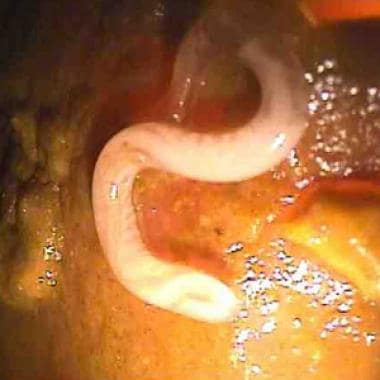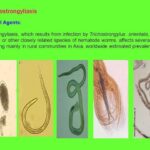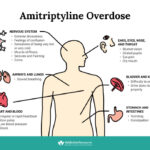Trichuriasis, also known as whipworm infection, is a significant soil-transmitted helminthic disease caused by Trichuris trichiura. This parasitic nematode inhabits the human large intestine, particularly the cecum and ascending colon. With hundreds of millions affected globally, particularly in tropical and subtropical areas, trichuriasis poses a considerable burden on public health, especially among children.

Understanding Trichuris trichiura: The Causative Agent
Trichuris trichiura is commonly known as the whipworm due to its characteristic shape—thin anterior end and thicker posterior end, resembling a whip. The adult worm embeds its anterior portion into the intestinal mucosa where it feeds and causes tissue damage.
Life Cycle of Trichuris trichiura
The infection begins when embryonated eggs from contaminated soil are ingested. These eggs hatch in the small intestine, and larvae migrate to the large intestine, where they mature into adults.
- Prepatent period: 60–70 days
- Lifespan: Adult worms may live for up to 1 year.
Epidemiology and Global Distribution of Trichuriasis
Trichuriasis is widespread in regions with warm, moist climates and poor sanitation. It is endemic in Southeast Asia, sub-Saharan Africa, Latin America, and parts of the Caribbean.
- At-Risk Populations: Children aged 5–15 years, individuals in poverty-stricken areas, those lacking access to clean water and proper sanitation.
- Transmission Mode: Fecal-oral route via ingestion of embryonated eggs.
Symptoms of Trichuriasis: Clinical Manifestations
The clinical severity depends on the worm burden. Light infections are typically asymptomatic, while heavy infections can cause significant morbidity.
Mild to Moderate Infections
- Intermittent abdominal pain
- Diarrhea
- Nausea
Severe Infections
- Chronic diarrhea with mucus and blood
- Tenesmus (feeling of incomplete evacuation)
- Rectal prolapse (especially in children)
- Iron-deficiency anemia
- Growth retardation and cognitive impairment in children
Diagnosis of Trichuriasis: Laboratory Techniques
Microscopic Stool Examination
- Standard Method: Identification of characteristic barrel-shaped eggs with bipolar plugs using light microscopy.
- Kato-Katz Technique: Enhances sensitivity in detecting moderate to heavy infections.
- Egg Count: Helps quantify infection severity.
Emerging Diagnostic Tools
- PCR-based methods for species-specific DNA detection
- Antigen detection for monitoring deworming efficacy
Treatment Options for Trichuriasis
Anthelmintic Therapy
- Albendazole (400 mg/day) for 3–5 days
- Mebendazole (100 mg twice daily) for 3 days
- Oxantel pamoate has demonstrated higher cure rates in recent studies
Combination Therapy
- Co-administration with ivermectin or oxantel pamoate increases efficacy, especially in high-intensity infections.
Follow-Up
- Post-treatment stool examination after 2–3 weeks to confirm clearance
Prevention and Control of Trichuriasis
An integrated approach is essential for long-term control of trichuriasis:
- Sanitation Improvements
- Construction and use of hygienic latrines
- Safe disposal of human waste
- Health Education
- Hand hygiene practices
- Avoiding consumption of unwashed vegetables
- Mass Drug Administration (MDA)
- WHO recommends periodic deworming in endemic areas, especially targeting school-age children
- Environmental Measures
- Safe agricultural practices to reduce soil contamination
Trichuriasis in Children: Impact and Intervention
Children are particularly vulnerable due to:
- Higher exposure to contaminated environments
- Weaker immune response
- Nutritional deficiencies exacerbated by the infection
Key Interventions
- School-based deworming campaigns
- Nutritional support and micronutrient supplementation
- Monitoring growth and development
Complications Associated with Chronic Trichuriasis
- Rectal prolapse due to prolonged straining and inflamed mucosa
- Anemia and malnutrition from chronic blood loss and nutrient absorption interference
- Cognitive deficits impacting educational performance and quality of life
Research and Emerging Trends
- Vaccine Development: Although no vaccine exists, research continues on helminth immunology.
- Drug Resistance Monitoring: Repeated deworming may select resistant strains.
- Improved Diagnostics: Development of rapid point-of-care tests is underway.
Managing and Eliminating Trichuriasis
Trichuriasis is a preventable and treatable parasitic infection with significant public health implications. Its control demands coordinated efforts in diagnostics, treatment access, hygiene promotion, and community-based interventions. Ensuring safe water and sanitation, especially in vulnerable populations, is crucial for breaking the cycle of infection.
Frequently Asked Questions:
Q1. What causes trichuriasis?
Trichuriasis is caused by the whipworm Trichuris trichiura, transmitted through ingestion of embryonated eggs from contaminated sources.
Q2. How is trichuriasis diagnosed?
Diagnosis is primarily made by identifying characteristic eggs in stool samples through microscopy.
Q3. Can trichuriasis be treated effectively?
Yes, it can be treated with albendazole, mebendazole, or oxantel pamoate, often requiring multiple-day regimens.
Q4. What populations are at highest risk?
Children in endemic regions with poor sanitation are at the greatest risk of infection and complications.
Q5. Is trichuriasis preventable?
Yes, through improved sanitation, hygiene practices, and periodic deworming programs in at-risk communities.

